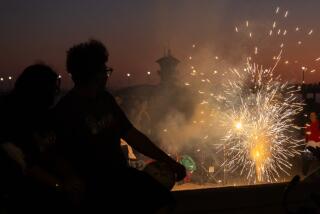Disney Light Show Stings Critics
While Disneyland tourists ooh and aah over the park’s spectacular holiday fireworks, a few blocks away, Anaheim homeowners are doing a little moaning and groaning of their own.
Fireworks were once for summertime and special occasions, but in 2000, Disneyland made them year-round. The park added the hugely popular “Believe . . . In Holiday Magic,” a fireworks and snow show that returned for the holidays this year. California Adventure also added LuminAria, a water and low-level fireworks attraction.
After the fireworks light up the sky and the tourists head to their hotels, Anaheim homeowners contend with the aftermath: occasional ashy fallout and a huge, moving cloud of stinky smoke.
“On the worst days, you can smell the gunpowder,” Anaheim resident Pat Murphy said. “And you can barely see the street lights on Katella [Avenue]. That’s how bad it is.”
Jim Anderson, a spokesman for Anaheim Homeowners for Maintaining their Environment, complained at a recent City Council meeting, prompting officials to ask city staff to investigate their concerns.
But Anaheim Fire Department Chief Jeff Bowman said Disneyland and California Adventure are following all the city codes.
“The Fire Department does not have the resources, the knowledge or the wherewithal to review the fallout,” Bowman said. “If they were that dangerous and noxious, why wouldn’t they have been shut down years ago?”
Disneyland Resort officials said they have logged 10 complaints this year. The South Coast Air Quality Management District has received 55 odor, smoke and fallout complaints in the last five years, but only three so far in 2001.
Fireworks have been studied periodically over the years, though usually as they relate to Fourth of July or other holiday events. Disneyland also recently commissioned its own study when it increased the number of shows, AQMD officials said.
That study, which air officials analyzed, determined that cancer risks were below the level that requires public notification. The study also found that fewer than two people in a million are exposed to excess cancer risk, said Jean Ospital, the air district’s health effects manager.
San Jose State University professor Kevin Perry conducted a study of fireworks in Washington state. He hasn’t requested funding or embarked on any additional studies, in part, he said, because “I don’t want to be considered the Grinch that stole people’s fireworks.”
Too much is unknown to reach any conclusions, Perry said. For example, he does not know the size of the particles--the smaller they are, the more dangerous--or what toxic substances the fireworks may form after they are released.
“I wouldn’t want to live where the smoke hits,” Perry said. “It takes an already polluted area--which is Los Angeles--and for the people downwind, makes it an extremely polluted area.”
But, Perry said, because of the large population in Southern California, fireworks probably play a very minor role in overall pollution.
Air district officials said they may not pursue any additional air sampling, but could end up focusing on complaints of material that eventually settles on the ground. They may place glass plates in areas where residents have reported such settling--although that could be a difficult thing to study because of heavy freeway traffic, construction and other pollutants in the area.
“Our goal would be to work with the city and local officials--City Council, Mayor Tom Daly, and also the Fire Department, because they basically are permitting this to occur,” said senior compliance manager Ed Pupka.
In San Diego, a similar fireworks debate is brewing over proposed expansion at SeaWorld. Resident Dino Russo accused the park of “pandering to tourists” with little regard to the health of local residents.
“It’s not just on New Year’s Eve or the Fourth of July,” Russo said. “It starts to add up. What we’re doing is layer after layer after layer. . . . Nobody wants to do a chemical analysis of this or study what the accumulate is.”
But SeaWorld and city officials said they are satisfied that the fireworks pose no significant health risks. And the city, so far, has approved SeaWorld’s plans to expand. The park’s next hurdle is the state Coastal Commission.
San Diego City Council liaison Ed Plank said, “At this point, our staff has concluded that there aren’t issues of significant air or water quality impact.”
Disneyland officials said they also have found no harmful effects and are in compliance with local, state and federal regulations. The residents, meanwhile, figure it’s going to be hard to change anyone’s mind.
“It’s very loud, very smoky and very bright,” said Kenneth Hensley, manager of Travelers World RV Park. “Sometimes there’s a sulfur smell. And there has been ash residue. It’s been falling on vehicles and causing some paint damage. A lot of people mind it, but it’s the price you pay. I think everybody considers it hopeless.”
More to Read
Sign up for Essential California
The most important California stories and recommendations in your inbox every morning.
You may occasionally receive promotional content from the Los Angeles Times.











